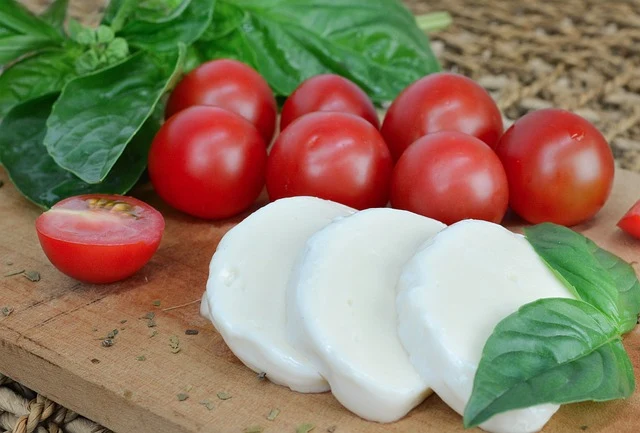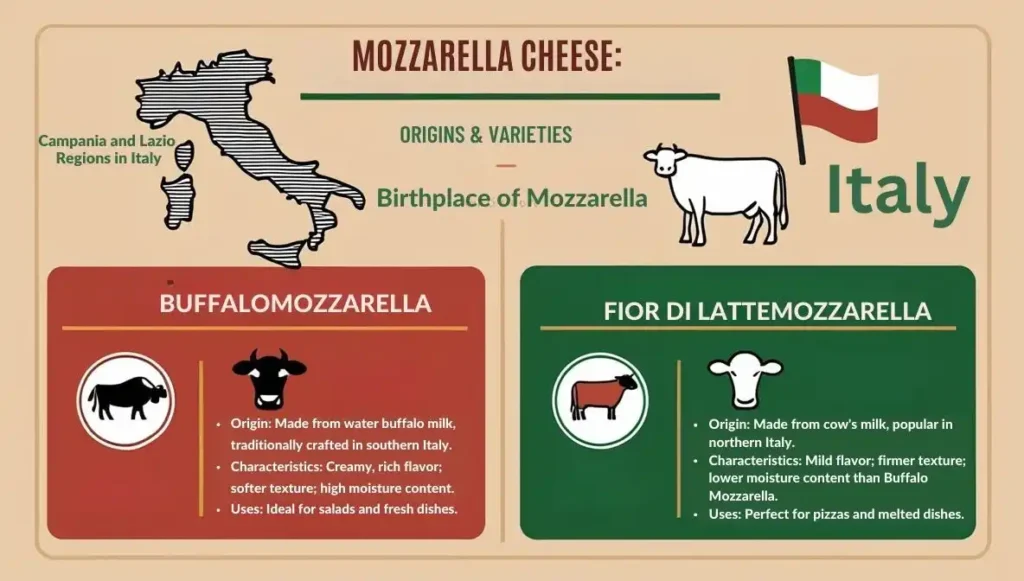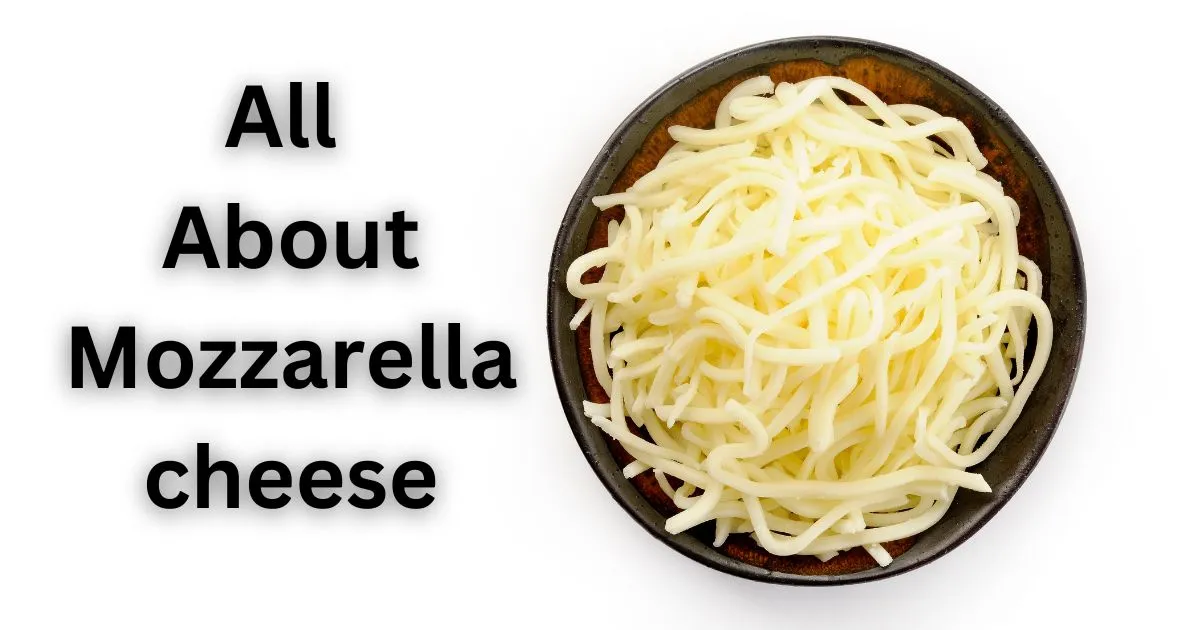Mozzarella cheese, pronounced “moh-zuh-REHL-lah,” is a beloved staple in Italian cuisine and around the world. Originating from Italy, this soft, white cheese is traditionally made from the milk of water buffaloes, though cow’s milk versions are now more common.
It is Italian fresh non-aged cheese made from both cow’s and buffalo milk with different name
- Mozzarella fior di latte or mozzarella: cow’s milk.
- Mozzarella di bufala: Italian buffalo’s milk.
Mozzarella is renowned for its delicate, milky flavour and smooth, stretchy texture, making it an essential ingredient in dishes like pizza, Caprese salad, and lasagna.
The colour of Fresh mozzarella is white. Due to its high moisture content, it is an occasional yellow/brown colour which comes from the enzyme R110. It is traditionally served the day after it is made but could be kept in brine for up to a week.

Top 12 Facts About Mozzarella Cheese:
- Source of Milk: Traditionally buffalo milk (can also be made from cow milk)
- Texture: Soft, smooth, and slightly elastic
- Colour: White
- Flavour: Mild, slightly tangy, and creamy
- Fat Content: 15-20%
- Aging Time: Fresh mozzarella is not aged; it’s typically consumed within a few days of production
- Pasteurized: Can be either pasteurized or raw, depending on the type
- Country of Origin: Italy
- Town: Produced in various Italian regions, notably in Campania
- Named After: The Italian word “mozzare,” meaning “to cut” (referring to the method of making the cheese)
- Certification: Some varieties, such as Mozzarella di Bufala Campana, have a Protected Designation of Origin (PDO) status
- Uses: Ideal for pizza, caprese salad, lasagna, and various Italian dishes
ALSO READ: Camembert Cheese: A Comprehensive Guide
Check out Wikipedia’s detailed entry on Mozzarella,
In this blog, we will go through the origins of Mozzarella, types, production, and uses in various dishes:
The Origins of Mozzarella

Mozzarella cheese traces its roots back to the region of Campania in southern Italy. Traditionally, it was made from the rich milk of water buffaloes, leading to the creation of the exquisite Mozzarella di Bufala.
Over time, cow’s milk has also become a popular base for making this cheese, known as Fior di Latte. The name “mozzarella” comes from the Italian word “mozzare,” which means “to cut off,” referring to the method of working the curd.
how is mozzarella made?
Mozzarella is traditionally made from the milk of Italian Mediterranean buffalo. A whey starter is added from the previous batch that contains thermophilic bacteria, and the milk is left to ripen so the bacteria can multiply.
The process of making mozzarella cheese begins with curdling the milk using rennet, an enzyme that separates the curds from the whey. The curds are then cut and heated to encourage the release of whey.
This is followed by stretching and kneading the curds in hot water, a step that gives mozzarella its distinctive texture and elasticity. The cheese is then shaped into balls or logs and can be eaten fresh or stored in brine.
ALSO READ: Cream Cheese Essentials
Types of Mozzarella
Mozzarella cheese comes in various forms, each offering a unique culinary experience:
- Fresh Mozzarella: Soft and moist, fresh mozzarella is typically sold in balls or logs and packed in water or whey. It has a delicate flavor and a creamy texture, making it perfect for salads, caprese, and fresh dishes.
- Low-Moisture Mozzarella: This type is firmer and has a longer shelf life than fresh mozzarella. It’s often used in cooking, especially in baked dishes like pizza and lasagna, where it melts beautifully and forms a gooey, stretchy layer.
- Smoked Mozzarella: Infused with a smoky flavor, this variety adds a distinct taste to dishes. It’s great for adding depth to sandwiches, pasta, and grilled dishes.
- Buffalo Mozzarella: Made from water buffalo milk, this type is rich and creamy with a tangy flavor. It’s a delicacy that enhances simple dishes with its unique taste and texture.
Use of mozzarella cheese
Mozzarella is used for most types of pizza and several pasta dishes or served with sliced tomatoes and basil in Caprese salad, sandwiches and some appetizers.

Pizza: Mozzarella is synonymous with pizza, melting into a stretchy, gooey topping that complements the sauce and crust perfectly.
Salads: Fresh mozzarella shines in salads, especially in the classic Caprese salad, where it’s paired with ripe tomatoes, fresh basil, and a drizzle of olive oil.
Pasta Dishes: Mozzarella adds creaminess to baked pasta dishes like lasagna, baked ziti, and stuffed shells.
Sandwiches and Paninis: Its melting quality makes mozzarella ideal for sandwiches and paninis, adding a satisfying stretch and creaminess.
Appetizers: Mozzarella sticks, made from breaded and fried mozzarella, are a popular appetizer enjoyed by many.
ALSO READ: The Ultimate Guide to Bel Paese Cheese
Nutritional Benefits of Mozzarella
Beyond its delicious taste, mozzarella cheese offers several nutritional benefits. It’s a good source of protein, calcium, and phosphorus, essential for bone health. Mozzarella is also lower in fat and calories compared to many other cheeses, making it a healthier choice for cheese lovers.
Conclusion
Mozzarella cheese is more than just an ingredient; it’s a beloved staple that enhances a wide array of dishes with its creamy texture and mild flavor. Whether enjoyed fresh or melted, in simple salads or complex baked dishes, mozzarella continues to delight and inspire chefs and food enthusiasts around the world. So, next time you reach for mozzarella, take a moment to appreciate its rich history and the culinary magic it brings to your table.
Our Complete Guide On 27 different types of cheese: their origin and uses
For expert insights on traditional mozzarella cheese-making, including the significance of buffalo milk, visit Alimentarium’s comprehensive guide for an in-depth exploration.
FAQ
-
What is mozzarella cheese?
Mozzarella cheese is a soft, white cheese originating from Italy, traditionally made from water buffalo milk. It is known for its creamy texture and mild flavor, making it a staple in various culinary applications.
-
What are the different types of mozzarella cheese?
Mozzarella cheese comes in several varieties, including fresh mozzarella (packed in water), low-moisture mozzarella (commonly used for pizza), and buffalo mozzarella, which is made from the milk of water buffalo.
-
How is mozzarella cheese produced?
Mozzarella cheese is produced through a process called pasta filata, where the curds are heated and stretched. This technique gives mozzarella its unique texture and allows it to melt beautifully.
-
What are some common uses for mozzarella cheese?
Mozzarella cheese is incredibly versatile and is commonly used in dishes such as pizza, lasagna, caprese salads, and sandwiches. It can also be enjoyed fresh with olive oil and herbs or melted in various recipes.
More on Cheese
- The Ultimate Guide to Cheddar Cheese
- Exploring Parmesan or Parmigiano-Reggiano cheese
- The Ultimate Guide to Ricotta Cheese
- Homemade Ricotta Cheese Recipe
- Complete guide to Feta cheese
- Discovering The Cottage Cheese
- The Ultimate Guide to Danish Blue Cheese
- The Ultimate Guide to Bel Paese Cheese
- Cream Cheese Essentials: Everything You Need to Know
- Camembert Cheese: A Comprehensive Guide
- 27 different types of cheese: their origin and uses
- Service of cheese in restaurants
- Cottage Cheese vs Paneer: Differences, Taste, Texture and More
Subscribe and join our community of hospitality professionals & students — get insights, tips, and the latest updates delivered straight to your inbox!







